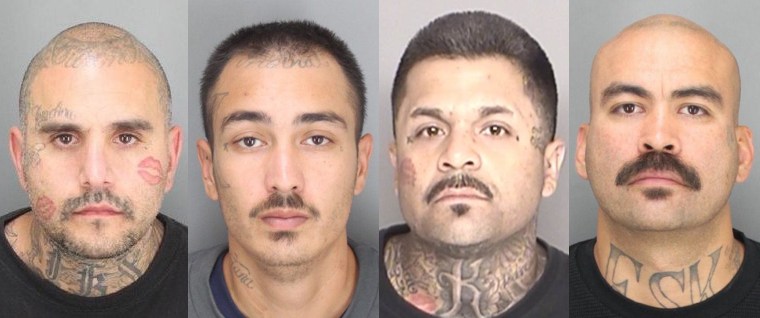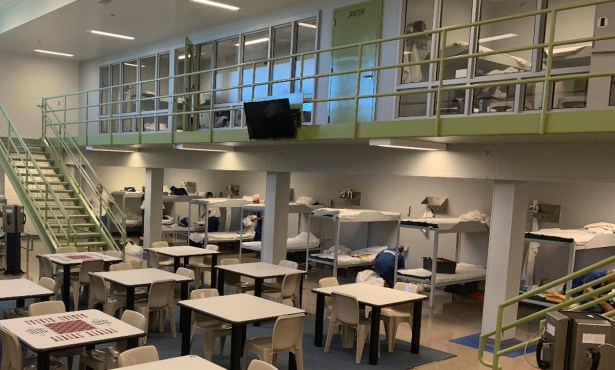Mexican Mafia, Meth, and Murder Plans
Grand Jury Hands Down Indictment Against Alleged Gang Bosses

Edgar “Playboy” Cordova and Benny “Conejo” Ybarra, two shot callers for Santa Barbara street gangs allegedly working for the more powerful Mexican Mafia prison gang, were indicted this week for conspiracy to commit murder. Law enforcement officials declined to comment on the charges, but the unsealed Grand Jury indictment offers at least a glimpse into the planned killing.
On August 14, 2013, Cordova reportedly spoke to Ybarra about where the intended victim lived and advised Ybarra, known to carry a .32 caliber handgun, to “creep up” on him. Later that day, after the pair failed to locate their target, Ybarra told Cordova, “I’m gonna get that fool, dog.” The two are being held in County Jail on $1.2 million bail each and are scheduled to appear in court on December 22.
Ybarra and Cordova were also indicted on charges of extortion and conspiracy to commit extortion, along with five other defendants similarly accused of shaking down legal businesses and area drug dealers. Jesse “Loco” Enriquez, Ulisses “Silent” Guzman, Arturo “Frosty” Renteria, Ruben “Evil” Regalado, and Sarah Elizabeth Montoya are all named in the indictment; Cordova and Regalado are charged with methamphetamine sales and transportation as well. A $600,000 arrest warrant has been issued for Montoya, who remains at large.
The allegations appear to align with warnings from authorities over the past year and a half that the Mexican Mafia — also known as La Eme — is digging deeper into Santa Barbara’s crime scene. The notorious syndicate often pulls the strings of Latino gangs, like the Sureños around Southern California, from behind prison walls, controlling drug sales and transportation through intimidation and force. While Santa Barbara County is home to a number of smaller neighborhood gangs, or “cliques,” they generally operate under the umbrella of the Sureños.
Phone calls and text messages among the defendants in the summer of 2013 and detailed in the indictment shed light on the organization’s inner workings. (A 16-month investigation leading up to the filing included the use of informants and wiretaps.) The group makes introductions and discusses collection methods, specifying who owes debts and in what amounts. The participants also organize payments with bank account info and MoneyPak purchases.
In one phone conversation on July 16, Cordova allegedly told Enriquez that every ” ‘hood” — Lompoc, Santa Maria, Goleta, and Santa Barbara’s Eastside and Westside — had to pay $500 a month to Mexican Mafia boss Michael “Boo” Moreno, who until his August 2013 arrest, controlled the gang’s activities in San Luis Obispo and Santa Barbara counties. In another conversation in early August, Cordova and a fellow gang member “discussed how to use violence to get individuals to pay taxes,” the indictment states.
Cordova, 29, was arrested last month at the San Diego border as he attempted to re-enter the United States from Mexico. He reportedly felt his arrest was imminent and wanted to avoid incarceration in a Mexican prison. A member of the Eastside Traviesos gang and named in the city’s proposed gang injunction, he was sentenced to six years in prison in 2005 for driving the car used in a drive-by shooting of Westsiders. Ybarra, 36, has a rap sheet that dates back to 1997 and includes felony drug and burglary charges. Both were implicated in the Santa Barbara Police Department’s massive gang crime crackdown last year, which was named Operation Falling Dawn as a subtle dig at the side of the city where the sun rises and its stronger gang resides.
Last month, Judge Rogelio Flores made a ruling that limited the amount of hard copy materials defense attorneys can provide their clients behind bars. Prosecutor Stephen Foley successfully argued that the safety of individuals named in discovery documents could be jeopardized by such free access. Defense attorneys have challenged the protective order, saying it’s unreasonable to expect them to read thousands of pages of evidence by themselves and that their clients are being denied the right to due process by not being able to adequately participate in their own cases. That issue is still being litigated.
Raymond “Boxer” Macias — a top tax collector who used to report directly to Moreno, and whose June 2013 arrest precipitated much of the evidence collecting in the current case — was convicted in September 2014 for his role in the kidnapping and torture of a Lompoc man over a drug debt. As of press time, he was scheduled to be sentenced on Wednesday to life in prison without parole. Enriquez had reportedly taken over collection duties from Macias before his own arrest last month.



